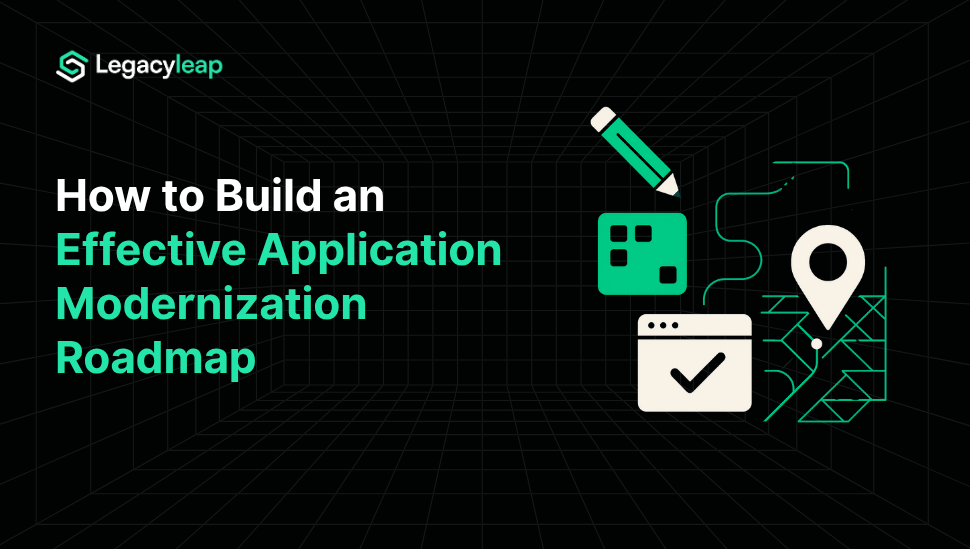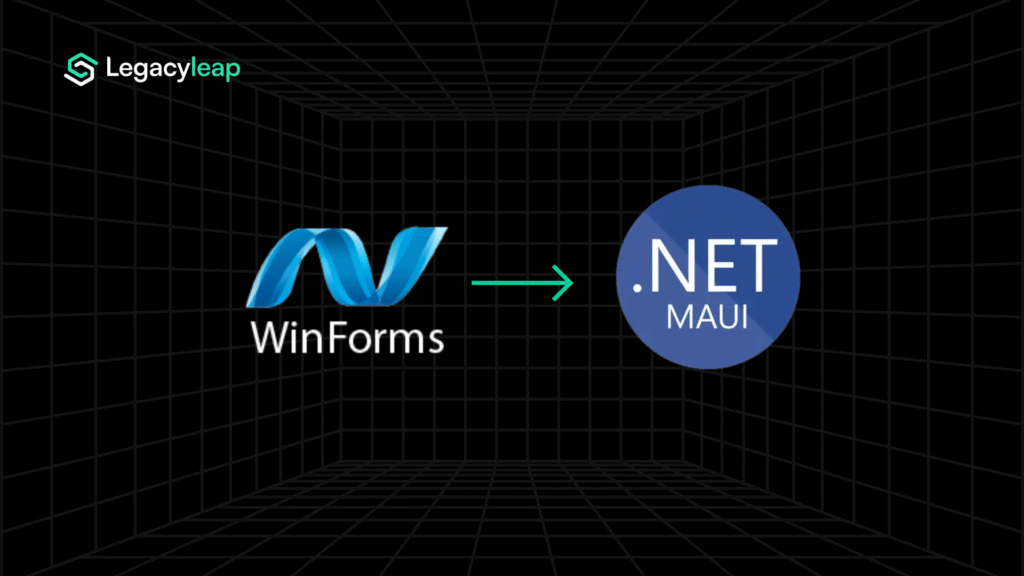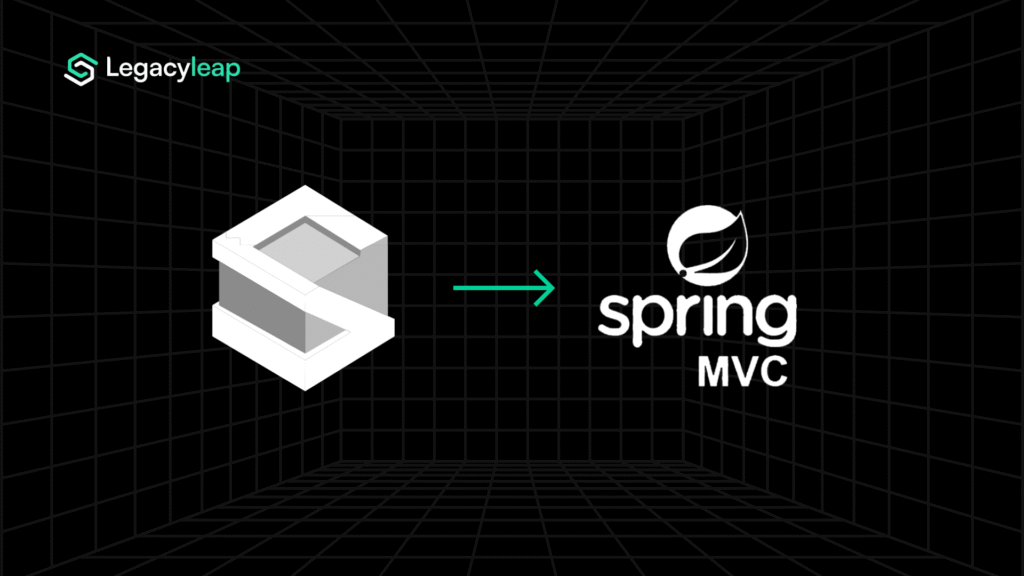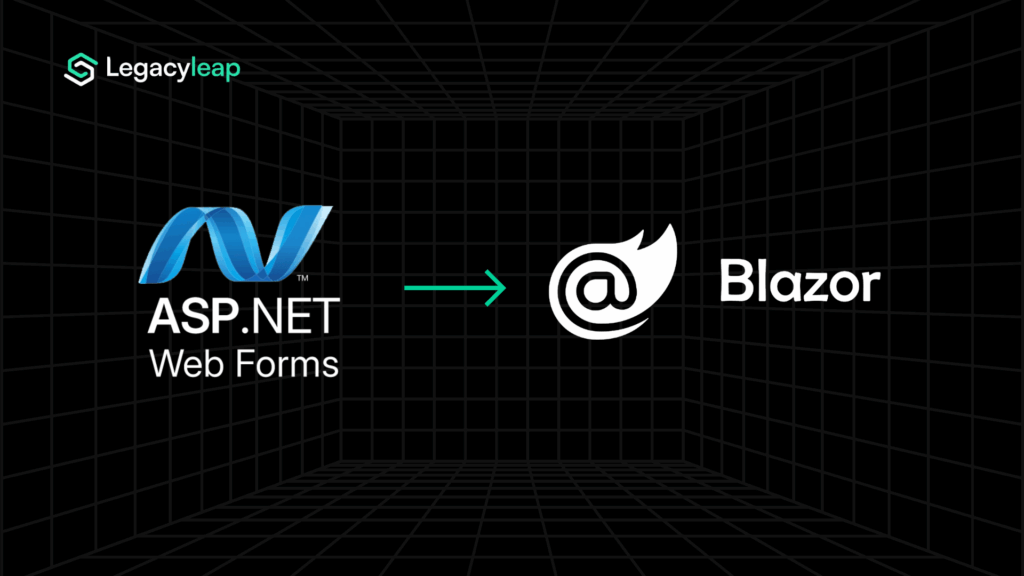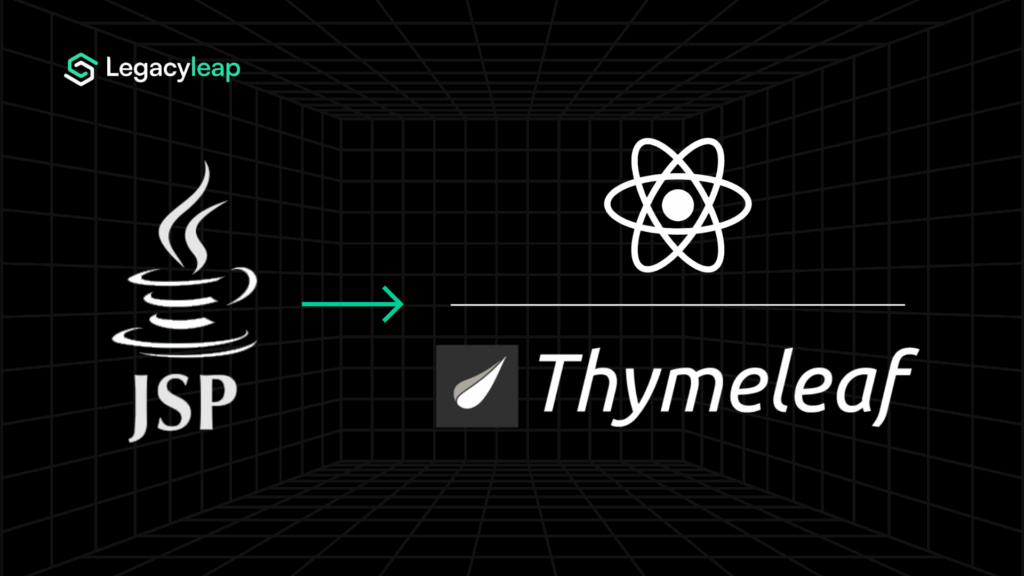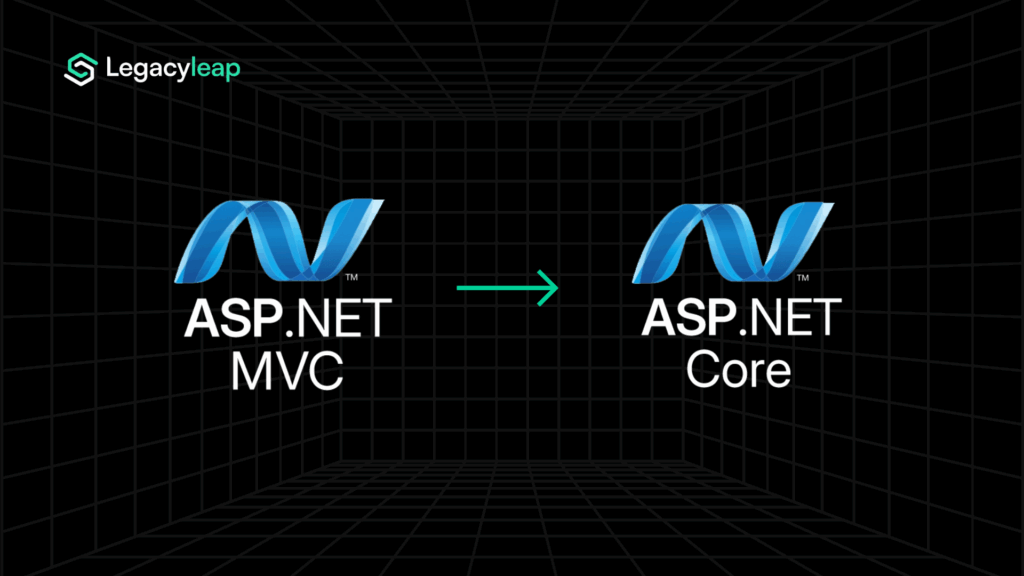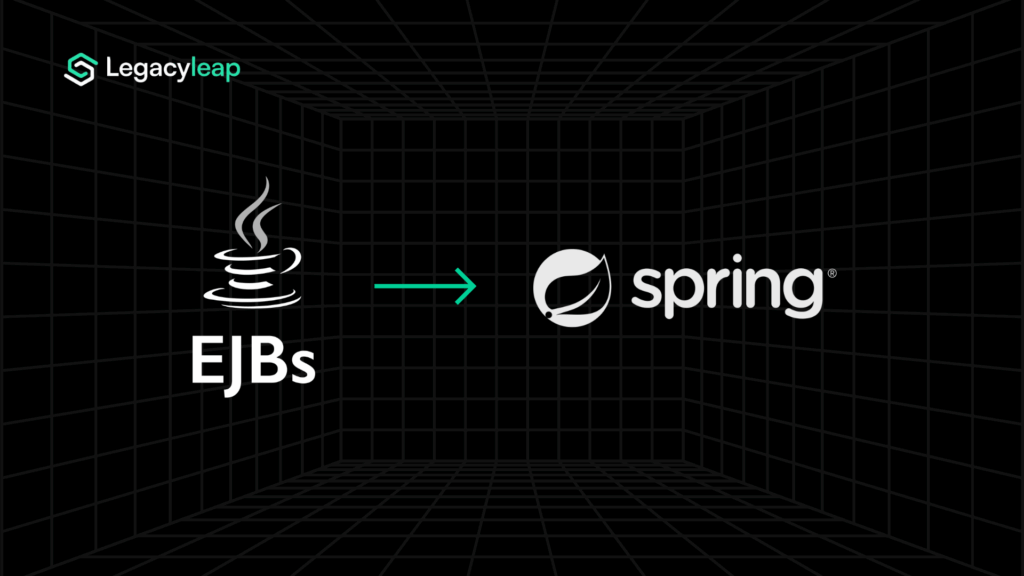Introduction: Why Application Modernization Matters
For more than a decade, enterprises have wrestled with legacy applications that slow innovation, inflate costs, and block progress toward digital transformation. These systems create bottlenecks in cloud adoption, limit the integration of AI and analytics, and compromise customer experience. What once felt “good enough” is now actively eroding competitiveness.
2025 marks a tipping point. AI, cloud, and automation have moved beyond experimentation into enterprise maturity. IDC projects that by 2025, nearly 60 percent of enterprise applications will rely on AI-driven features for efficiency, security, and decision support. Organizations that fail to modernize their application estates risk missing not just incremental gains but an entire new operating model.
The cost of delay is measurable:
- Security exposure as outdated frameworks stop receiving patches.
- Escalating licensing and infrastructure fees that drain IT budgets.
- Compounding technical debt that makes every new feature slower and riskier to deliver.
From a boardroom perspective, modernization is no longer a discretionary IT initiative. It is a direct enabler of agility, customer trust, and cost control. And in 2025, AI has emerged as the force multiplier that makes the modernization journey both faster and more predictable.
The Evolution of Modernization Approaches
Modernization has always been a balancing act between risk, cost, and value delivery. But with AI at enterprise scale, the nature of that balance is changing. Two comparisons illustrate the shift.
Traditional vs AI-Powered Modernization
| Factor | Traditional Modernization | AI-Powered Modernization (2025) |
| Time to Delivery | Multi-year programs | Months, accelerated by automated code scanning and AI-generated test suites |
| Cost | High upfront investment, uncertain ROI | Lower upfront cost with measurable ROI through predictive analytics |
| Dependency Mapping | Manual discovery across systems | AI-driven dependency mapping in hours, not weeks |
| Testing & Validation | Manual regression testing cycles | Automated regression and unit test generation |
| Risk Management | High risk of scope creep and overruns | Dynamic AI-assisted fallback strategies and real-time risk analysis |
This shift doesn’t eliminate complexity, but it changes the rules of engagement. AI reduces the guesswork, accelerates the feedback loop, and gives modernization leaders levers for both speed and control.
Also read: How Can Gen AI Drive Every Step of Your Modernization Journey?
Ad-Hoc vs Roadmap-Driven Modernization
| Factor | Ad-Hoc Modernization | Roadmap-Driven Modernization |
| Business Alignment | Fragmented, short-term fixes | Strategic, aligned with enterprise objectives |
| Risk Profile | Uncoordinated changes increase instability | Phased sequencing minimizes disruption |
| Technical Debt | Often worsens debt by layering fixes | Systematically reduces legacy dependencies |
| Agility | Teams operate in silos | Organization-wide agility with clear milestones |
The contrast is stark. Organizations that treat modernization as a sequence of isolated projects rarely realize full value. Those that operate with a roadmap create repeatable wins, sustained momentum, and stakeholder alignment.
Boardroom takeaway: The combination of AI-powered acceleration and roadmap discipline makes modernization in 2025 not just achievable but strategically urgent. The companies that move first will convert their technical foundations into a competitive advantage.
Here’s how enterprises should look at application modernization roadmaps in 2025.
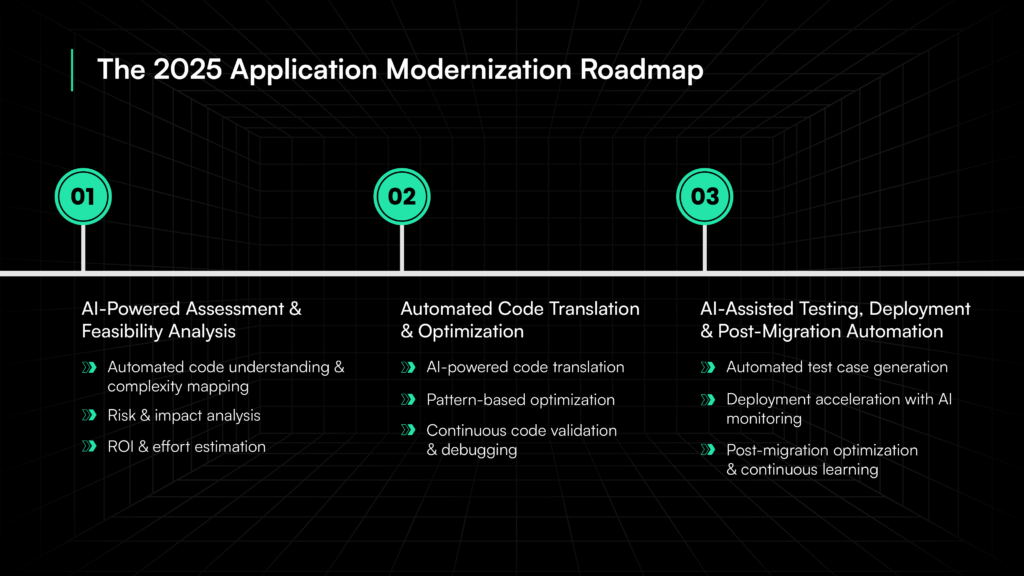
Benefits of an Application Modernization Roadmap in the AI Era
The strategic value of a roadmap has always been clear: it creates predictability, stakeholder alignment, and scalability. In the AI era, these benefits are amplified by speed and financial impact.
- Predictability: Roadmaps provide visibility into timelines and dependencies. With AI-driven insights, leaders gain even greater foresight into risks and costs.
- Stakeholder alignment: A roadmap ensures cross-functional buy-in. AI enhances transparency by turning technical complexity into executive-ready metrics.
- Scalability: Phased modernization prevents disruption while enabling incremental value. AI further accelerates scaling by automating testing, deployment, and monitoring.
- Speed and cost savings: According to McKinsey, organizations that embed AI into modernization efforts report project accelerations of up to 40 percent and cost reductions of 20–30 percent [McKinsey, 2024].
Boardroom takeaway: The ROI of modernization is no longer a distant promise. In 2025, AI-enhanced roadmaps deliver tangible financial outcomes in months, not years.
Core Steps to Building an Effective AI-Enhanced Modernization Roadmap
A roadmap remains the backbone of successful modernization. What changes in 2025 is the toolkit available to leaders. Every phase of the modernization journey, from assessment through optimization, can now be accelerated, de-risked, and scaled with AI.
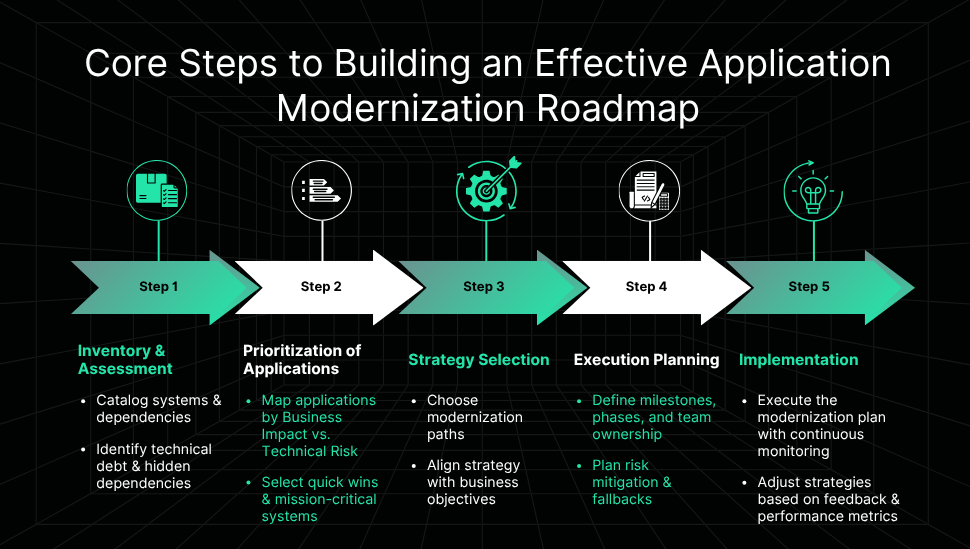
Step 1: Inventory & Assessment
- Traditional approach: Enterprises begin with a system-wide catalog of applications, dependencies, and technical debt. This baseline helps identify risks, duplication, and inefficiencies.
- AI enhancement: AI-powered code scanning tools now automate much of this work. They parse millions of lines of legacy code, detect hidden dependencies, flag security gaps, and even provide ROI projections for modernization efforts. What once required weeks of manual discovery can be completed in days, giving leadership a faster and more reliable foundation for decision-making.
Step 2: Prioritization of Applications
- Traditional approach: Prioritization is based on a balance of business impact and technical risk. Applications critical to revenue or customer experience often rise to the top, alongside low-effort quick wins that can build early momentum.
- AI enhancement: Predictive analytics elevate this process. AI models analyze usage patterns, cost data, and historical incidents to recommend modernization priorities that optimize both ROI and risk reduction. This turns prioritization from a subjective exercise into a data-driven strategy.
Step 3: Strategy Selection
- Traditional approach: Leaders choose from classic modernization strategies: rehost, refactor, replatform, rewrite, or replace. Each option involves trade-offs in cost, complexity, and long-term value.
- AI enhancement: Compiler intelligence and large language models now assist in suggesting the optimal strategy for each application. By analyzing code quality, performance bottlenecks, and architectural fit, AI generates scenario-based recommendations, helping leaders pick a path with greater confidence.
Step 4: Execution Planning
- Traditional approach: Planning requires defining milestones, assigning ownership, and creating risk mitigation plans. These guardrails ensure that modernization proceeds in a controlled, measurable way.
- AI enhancement: AI tools enable dynamic timeline generation that adapts as dependencies shift. Automated fallback strategies can also be designed in advance, reducing the impact of unexpected issues. This increases resilience without extending project timelines.
Step 5: Implementation
- Traditional approach: Rollouts are phased, with continuous monitoring of performance, reliability, and cost. Governance frameworks keep modernization aligned with long-term goals.
- AI enhancement: AI enables automated code translation, real-time regression testing, and accelerated deployment cycles. Monitoring is augmented by AI observability platforms that detect anomalies before they escalate. The result is modernization that is not only faster but also safer.
Boardroom takeaway: A disciplined roadmap structure combined with AI augmentation changes the economics of modernization. Enterprises can move faster while reducing both risk and cost.
Also read: How to Use Gen AI to Achieve Efficient Modernization Deployment
Common Pitfalls and Risks to Avoid
Even with clear roadmaps, modernization journeys can falter. Many organizations repeat avoidable mistakes, and in 2025, new risks have emerged with AI-driven approaches.
Pitfalls in Traditional Modernization
- Underestimating technical debt. Leaders often misjudge the effort required to untangle decades of accumulated dependencies, resulting in spiraling timelines and costs.
- Attempting “big-bang” rewrites. Large-scale rewrites without incremental milestones almost always run over budget and underdeliver.
- Poor documentation. Missing or outdated documentation creates gaps that stall teams mid-project, introducing rework and frustration.
Risks in AI-Powered Modernization
- AI hallucinations. While AI accelerates code generation and dependency mapping, unchecked outputs may introduce errors or inaccuracies that slip into production.
- Compliance gaps. AI-assisted modernization can inadvertently bypass governance guardrails, especially around sensitive data and intellectual property.
- Over-reliance on automation. AI is a powerful enabler but not a replacement for architectural judgment or business alignment.
There are two ways in which Legacyleap solves this.
1. Hybrid AI + Human Expertise Model
Neither a fully AI-driven nor a fully manual approach is ideal. The best approach is a hybrid model, where AI automates repetitive, high-volume tasks while human experts ensure quality, compliance, and business logic preservation.
- AI automates code migration, optimization, and validation.
- Human experts review, refine, and enforce compliance standards.
- Together, they deliver faster, more accurate, and more reliable modernization.
2. AI Gateway and Middleware
At Legacyleap, we don’t let AI operate in isolation. Instead, we’ve designed a secure AI middleware layer that acts as a governance and validation checkpoint.
This middleware:
- Prevents AI models from directly interacting with enterprise systems to ensure security.
- Keeps sensitive data isolated while still leveraging AI for automation.
- Supports both public and private LLMs, allowing enterprises to choose the best-fit AI model while maintaining control over their data.
- Continuously validates AI-generated code to catch and correct errors before deployment.
For more info on this, check out our deep dive on The Role of AI Middleware in Gen AI-Powered Modernization.
By combining AI-driven automation with enterprise-grade security and expert oversight, Legacyleap delivers modernization that is fast, cost-effective, and risk-mitigated, ensuring that companies can modernize with confidence.
Best Practices for Successful Modernization
Here are some best practices to ensure that your application modernization efforts are successful and sustainable:
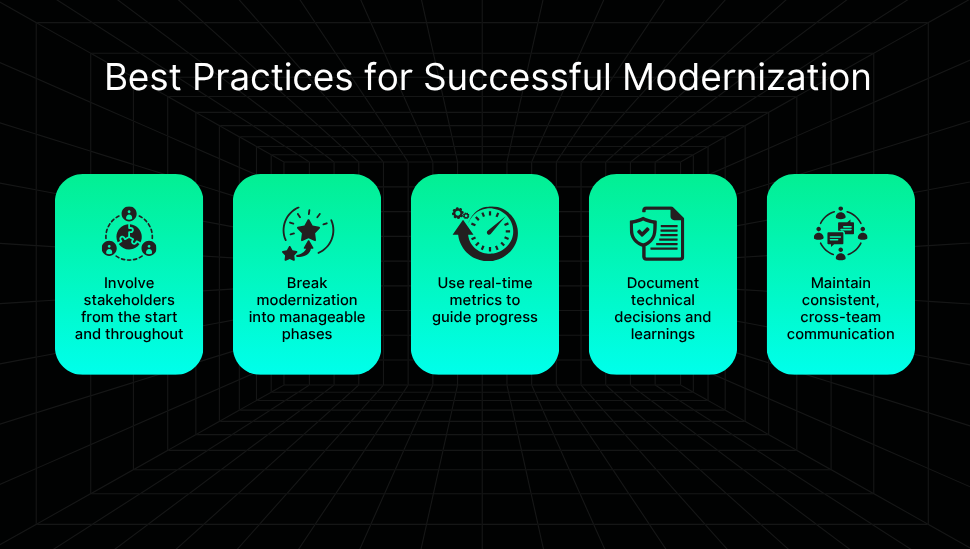
- Stakeholder engagement: Engage all relevant stakeholders from the outset and keep them involved throughout the process. Their insights and buy-in are critical for smooth execution and alignment with business priorities.
- Incremental approach: Modernization should be approached in phases rather than a “big bang” approach. Breaking down the process into smaller, manageable phases reduces complexity and allows for quicker adjustments as you move forward.
- Continuous monitoring: Implement real-time metrics to continuously assess the progress of the modernization effort. This will help you make data-driven adjustments to ensure the process remains on track.
- Knowledge management: Ensure thorough documentation of the entire modernization process, including technical changes, decisions, and learnings. This will not only serve as a reference for future projects but will also aid in training and knowledge transfer within the organization.
- Clear communication across teams: Ensure consistent and transparent communication across all teams involved in the modernization process. Regular updates, discussions, and feedback loops are essential for ensuring alignment, addressing roadblocks early, and fostering collaboration.
How Legacyleap Makes Modernization Future-Ready
On average, businesses spend $3M per year just to keep outdated systems running. In fact, 65% of companies now allocate over $2M annually to legacy upkeep, often just to patch inefficiencies rather than drive innovation.
So it’s clear that for years, mid-market companies have been stuck between two impossible choices: either continue maintaining outdated systems at enormous costs or embark on a modernization journey so expensive and complex that it often fails before it even begins.
Take the case of a national fuel distribution software company we recently worked with.
With a revenue of £5 million per year, they knew modernization was inevitable. But if the price tag was a million dollars upfront, it simply wasn’t feasible. However, if the cost was structured efficiently—say, $100,000 over five years—it became a viable, strategic investment.
That’s the gap we’ve filled with AI-driven modernization today. By reducing costs by 40-50%, companies that once saw modernization as out of reach can now make it part of their growth strategy.
1. A Proven Modernization Framework
Our modernization playbook has been refined across industries and geographies. It is built on a five-phase framework that ensures no detail is overlooked:
- Comprehensive assessment: We start by cataloging every system, dependency, and interface. This creates a single source of truth that guides the entire journey.
- Automated documentation: Using proprietary discovery tools, we generate detailed documentation for legacy applications that often lack reliable references. This eliminates the guesswork that derails many programs.
- Risk-based prioritization: Applications are scored on technical risk, business value, and effort. This ensures quick wins without losing sight of high-impact systems.
- Phased vs. big-bang rollouts: Depending on organizational appetite and operational requirements, we deliver either phased migrations with minimal disruption or strategically timed big-bang transformations.
- Governance-first execution: Compliance, security, and stakeholder alignment are embedded from day one. Executive dashboards provide transparent progress metrics to business and IT leaders alike.
This disciplined framework keeps modernization predictable and measurable, two qualities every CIO and CFO demands.
2. The AI Differentiators That Change the Game
What sets Legacyleap apart in 2025 is how we combine this proven framework with next-generation AI accelerators:
- Compiler-driven code transformation: Our proprietary compiler technology can automatically replatform or refactor legacy code, reducing months of manual effort to weeks.
- Gen AI-powered analysis: Large language models scan millions of lines of code to surface inefficiencies, hidden dependencies, and security vulnerabilities that human teams often miss.
- AI middleware governance: Acting as a safety layer, our middleware validates AI outputs, enforces compliance guardrails, and prevents hallucination risks from reaching production.
- Predictive roadmapping: AI generates ROI-based modernization scenarios, enabling leaders to compare cost, time, and risk profiles across multiple paths.
- Dynamic execution planning: As dependencies shift, AI recalibrates project timelines and recommends fallback strategies, ensuring programs stay resilient under real-world conditions.
The result: modernization that is not only faster but also safer and more cost-efficient.
3. Outcomes in Practice
Our clients have seen measurable impact:
- Cost savings: Enterprises have consistently reduced modernization costs by up to 40–50 percent by leveraging Legacyleap’s AI-driven code transformation.
- Timeline acceleration: Projects that once spanned three years are now being executed in 12–18 months with AI-assisted automation.
- Operational resilience: Governance-first AI middleware ensures compliance requirements are continuously met, even in highly regulated industries.
- Stakeholder confidence: Executive-ready dashboards translate technical progress into clear business outcomes, helping boards and leadership teams stay aligned.
As our founder recently put it,
“We don’t just feed your code into OpenAI and hope for the best. We’ve built sophisticated layers around code understanding and representation. By combining Gen AI with compiler technologies, we ensure accuracy, reliability, and real-world applicability.
– Murali Vivekanandan, Founder
Boardroom takeaway: This approach is what makes Legacyleap the only truly comprehensive Gen AI-powered modernization platform. With Legacyleap, enterprises gain both the roadmap discipline to modernize predictably and the AI accelerators to modernize faster.
The Future of Modernization: AI as the New Standard
Modernization has always been framed as a risk. But in truth, the real risk is delay. Every quarter that enterprises postpone modernization, costs compound, technical debt grows, and security exposures widen.
Today, only 34% of companies handle app modernization fully in-house, while 31% rely entirely on external partners, and 34% take a hybrid approach.
The trend is clear: Organizations recognize that modernization requires specialized knowledge beyond internal resources. Smart modernization today means strategic collaboration, combining institutional knowledge with specialized external capabilities.
By 2026, AI-driven modernization will no longer be a differentiator, but the standard. Enterprises that act now will already be operating on modern, AI-enhanced foundations, while competitors struggle through catch-up transformations.
See what Legacyleap can do for you in action with a $0 AI-powered assessment and take the first step toward an intelligent, cost-effective transformation.
FAQs
They combine the structure of a roadmap with AI’s ability to parse millions of lines of code, surface hidden dependencies, and simulate execution risks. This means CIOs get both predictability and speed, something neither ad-hoc projects nor manual roadmaps could deliver.
AI-driven prioritization weighs business impact, technical risk, and potential ROI. For example, systems with high compliance exposure or scalability issues are flagged early, while low-dependency apps become “quick wins.” This prevents wasted effort and accelerates visible results.
Yes. AI automates mapping of sensitive data flows (e.g., PHI, PCI) and generates audit-ready test cases. Human-in-the-loop validation ensures compliance with HIPAA, PCI DSS, and other regulations, so enterprises can modernize without regulatory risk.
Without governance, AI can introduce hallucinations or overlook compliance nuances. That’s why Legacyleap uses a hybrid model: compiler-grade validation, middleware governance, and human oversight at every stage to ensure accuracy and accountability.
Typical outcomes include 40–50% cost savings and 12–18 month acceleration in delivery. ROI is realized in stages: early wins from quick-to-modernize apps, mid-term savings from reduced infra/ops costs, and long-term agility from cloud-native architectures.

